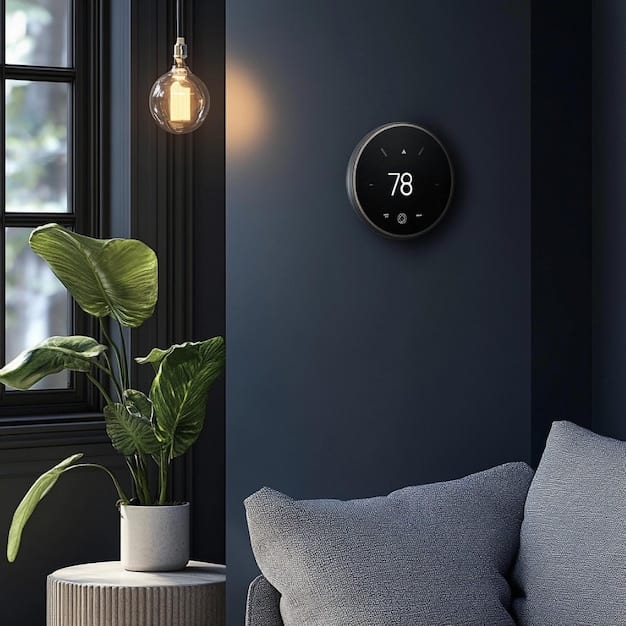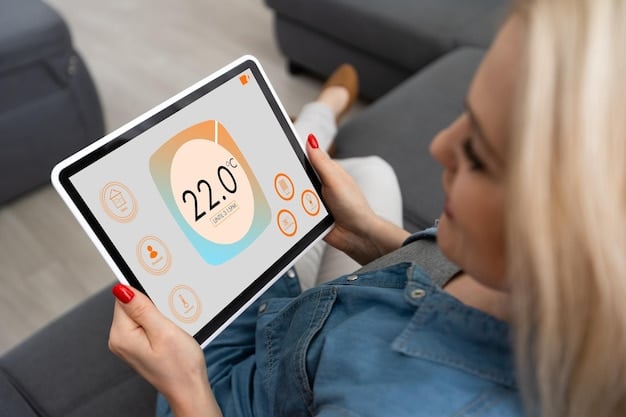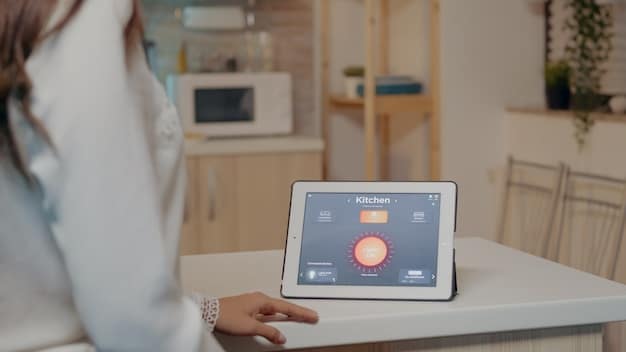Reduce Energy Consumption: Smart Thermostat Scheduling Guide

Reducing energy consumption by 15% is achievable through smart thermostat scheduling. This step-by-step guide outlines how to effectively program your smart thermostat to optimize energy usage, lower utility bills, and create a comfortable home environment.
Ready to save money and energy? This guide will show you how to reduce energy consumption by 15% with smart thermostat scheduling, making your home more efficient and comfortable.
Understanding Smart Thermostats and Energy Savings
Smart thermostats offer advanced features that go beyond traditional thermostats, allowing for precise temperature control and automated scheduling. Understanding how these devices work is the first step toward maximizing energy savings in your home.
How Smart Thermostats Work
Smart thermostats connect to your home’s Wi-Fi network, enabling remote control and monitoring via a smartphone app or web interface. They learn your heating and cooling patterns, allowing you to create customized schedules tailored to your lifestyle.
Benefits of Smart Thermostats
Besides remote access and scheduling, smart thermostats offer a range of benefits, including energy reports, geofencing capabilities, and integration with other smart home devices. These features help you optimize energy usage and reduce waste.
- Remote Control: Adjust your thermostat from anywhere using your smartphone.
- Custom Scheduling: Create personalized schedules for different days of the week.
- Energy Reports: Track your energy usage and identify areas for improvement.
- Geofencing: Automatically adjust the temperature when you leave or approach home.
By leveraging these features, homeowners can significantly reduce their energy consumption and lower their utility bills. Understanding the specific functionalities of your smart thermostat is key to achieving the desired energy savings.
Step-by-Step Guide to Smart Thermostat Scheduling
Setting up an effective schedule on your smart thermostat is crucial for reducing energy consumption by 15%. Here’s a comprehensive guide to help you create a schedule that fits your lifestyle and maximizes energy savings.
Analyzing Your Daily Routine
Start by analyzing your daily routine. Identify the times when you’re typically at home, away at work or school, and asleep. This information will form the basis of your thermostat schedule.
Creating a Basic Schedule
A basic schedule should include different temperature settings for when you’re home, away, and asleep. For example, you can set a lower temperature for heating during the day when you’re away and a higher temperature when you’re home in the evening.

- Wake-up Time: Set the thermostat to your preferred comfortable temperature.
- Away Time: Reduce the temperature for energy efficiency.
- Return Time: Increase the temperature before you arrive home.
- Sleep Time: Lower the temperature for optimal sleep and energy savings.
By following these steps, you can create a basic schedule that aligns with your daily activities and helps you save energy without sacrificing comfort. Remember to adjust the schedule seasonally to optimize energy use year-round.
Optimizing Your Smart Thermostat Schedule for Maximum Savings
Once you have a basic schedule in place, you can fine-tune it to achieve even greater energy savings. Optimizing your schedule involves making small adjustments and leveraging advanced features of your smart thermostat.
Using Geofencing
Geofencing is a feature that uses your smartphone’s location to automatically adjust the thermostat. When you leave a pre-defined area around your home, the thermostat switches to an energy-saving mode. When you return, it adjusts back to your preferred temperature.
Leveraging Learning Capabilities
Many smart thermostats learn your habits over time and automatically adjust the schedule to optimize energy usage. Allow your thermostat to learn your preferences for a few weeks and then review the suggested changes.
- Monitor Energy Reports: Track your energy usage to see the impact of your schedule.
- Adjust Seasonally: Change your schedule to account for seasonal temperature variations.
- Utilize Smart Features: Explore advanced features like weather-aware adjustments.
By taking advantage of geofencing and learning capabilities, you can achieve significant energy savings with minimal effort. Regular monitoring and adjustments will ensure your schedule continues to meet your needs and optimize energy use.
Advanced Features of Smart Thermostats for Energy Efficiency
Smart thermostats come equipped with a variety of advanced features designed to enhance energy efficiency. Utilizing these features effectively can further reduce energy consumption by 15% and improve your home’s overall energy performance.
Weather-Aware Adjustments
Some smart thermostats can automatically adjust the temperature based on the weather forecast. This feature can help you save energy by reducing heating or cooling when the weather is mild.
Integration with Smart Home Systems
Smart thermostats can integrate with other smart home devices, such as smart lights and smart blinds, to create a comprehensive energy management system. This integration allows for synchronized energy savings across your home.

- Voice Control: Use voice commands to adjust the temperature.
- IFTTT Integration: Create custom rules to automate thermostat settings.
- Multi-Zone Control: Manage temperature in different areas of your home independently.
By exploring these advanced features, you can create a truly smart and energy-efficient home. Integrating your thermostat with other smart devices and utilizing weather-aware adjustments can result in substantial energy savings and increased comfort.
Troubleshooting Common Smart Thermostat Issues
While smart thermostats are generally reliable, you may encounter some issues from time to time. Understanding common problems and how to troubleshoot them can help you maintain optimal energy savings and comfort.
Connectivity Problems
If your smart thermostat loses its Wi-Fi connection, you may not be able to control it remotely. Check your internet connection and ensure the thermostat is properly connected to your network.
Incorrect Temperature Readings
If the thermostat is displaying incorrect temperature readings, it may be improperly calibrated or located in a drafty area. Try recalibrating the thermostat or moving it to a more central location.
- Scheduling Issues: Double-check your schedule settings and ensure they are correctly programmed.
- App Problems: Update the thermostat app on your smartphone to the latest version.
- Professional Help: If you can’t resolve the issue, contact a professional HVAC technician.
By addressing these common issues promptly, you can ensure your smart thermostat continues to function properly and deliver the energy savings you expect. Regular maintenance and troubleshooting can prevent problems from escalating.
Measuring Your Energy Savings
After implementing smart thermostat scheduling, it’s important to measure your energy savings to determine the effectiveness of your efforts. Monitoring your energy usage can provide valuable insights and help you fine-tune your approach.
Comparing Energy Bills
Compare your energy bills from before and after implementing smart thermostat scheduling. Look for a noticeable reduction in energy consumption and costs.
Using Energy Monitoring Tools
Many smart thermostats provide energy monitoring tools that track your energy usage over time. Use these tools to identify areas where you can further reduce energy consumption.
- Calculate ROI: Determine the return on investment of your smart thermostat.
- Track Usage Patterns: Monitor how your energy usage changes with different schedules.
- Adjust as Needed: Use the data to make informed adjustments to your thermostat settings.
By measuring your energy savings, you can validate the effectiveness of your smart thermostat schedule and make data-driven decisions to further optimize your energy usage. Regular monitoring and analysis are crucial for maximizing your energy savings.
| Key Point | Brief Description |
|---|---|
| 💡 Smart Scheduling | Program thermostat for different times of day to save energy. |
| 📍 Geofencing | Automatically adjust temp based on your location. |
| 📈 Energy Reports | Track usage and identify areas for improvement. |
| 🌡️ Weather-Aware | Adjust temperature based on weather forecasts. |
Frequently Asked Questions
▼
A smart thermostat is a device that connects to your home’s Wi-Fi and allows you to control your heating and cooling systems remotely. It learns your preferences and adjusts the temperature automatically.
▼
Geofencing uses your smartphone’s location to detect when you leave or approach your home. It adjusts the thermostat to an energy-saving mode when you’re away and restores your preferred settings when you return.
▼
Yes, many smart thermostats are compatible with voice assistants like Amazon Alexa and Google Assistant. You can use voice commands to adjust the temperature without using the app.
▼
It’s a good idea to review and adjust your thermostat schedule seasonally. This ensures that it aligns with changing weather conditions and your evolving lifestyle for optimal energy savings.
▼
If your thermostat loses its Wi-Fi connection, check your internet router and the thermostat’s connection settings. You may need to reconnect it to your network to restore remote control.
Conclusion
By following this step-by-step guide, you can effectively reduce energy consumption by 15% with smart thermostat scheduling. Start by analyzing your daily routine, create a basic schedule, and then optimize it using advanced features like geofencing and weather-aware adjustments. Monitoring your energy savings and troubleshooting common issues can help you maintain optimal energy efficiency and comfort in your home.





